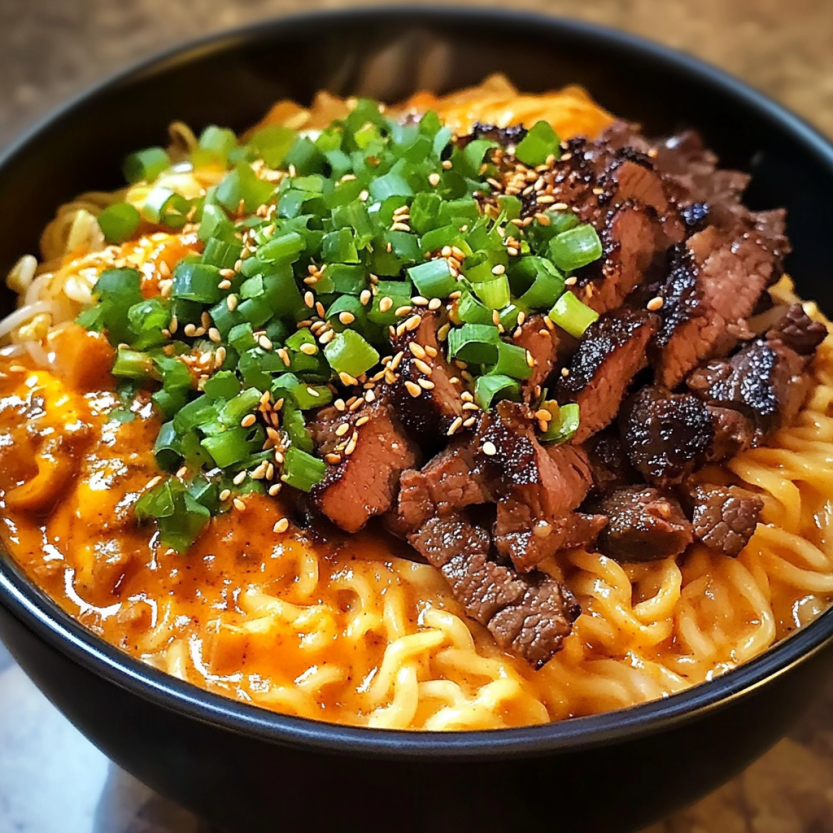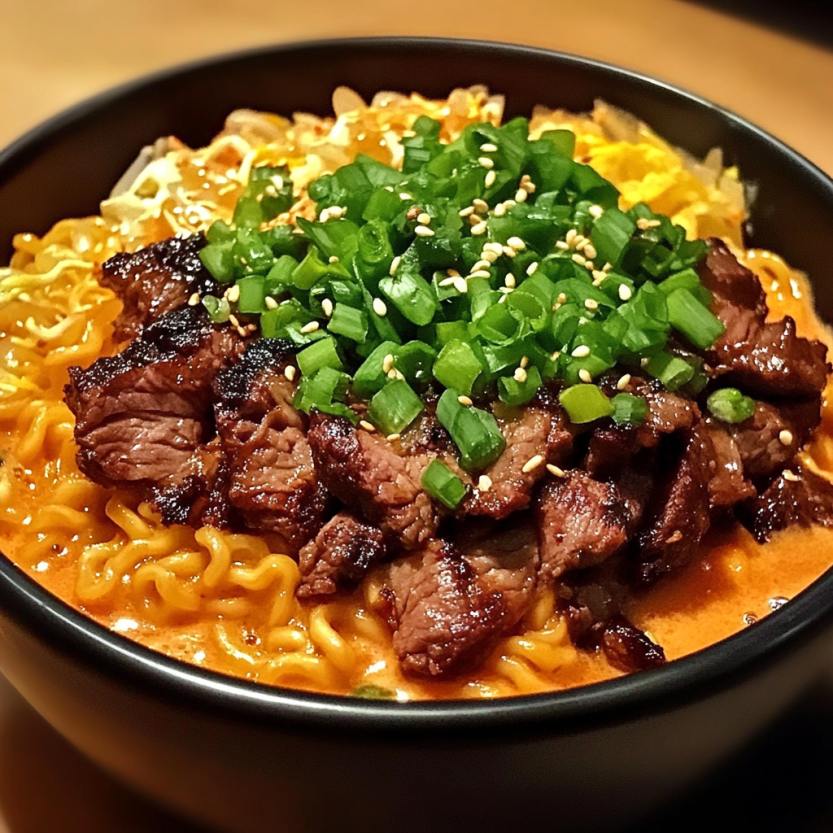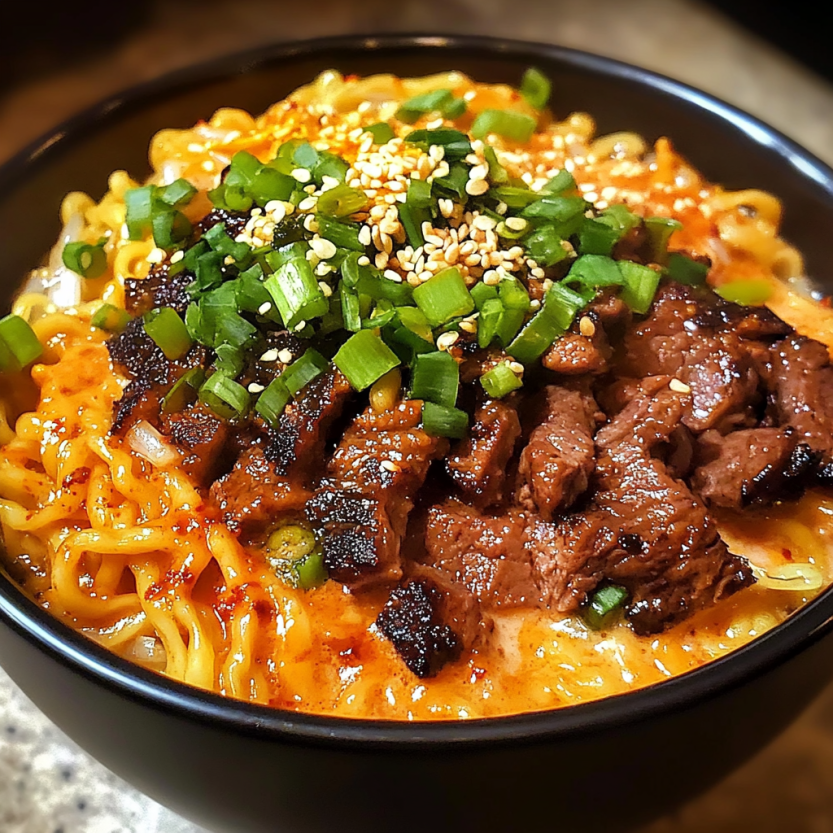 Save
Save
This spicy Korean ramen transforms basic noodles into a restaurant-worthy feast. The tender slices of marinated beef and creamy sauce create a perfect balance of heat, richness, and umami flavors in every spoonful of this comforting bowl.
I first created this recipe during a particularly cold winter when I was craving something warming but exciting. What started as a random kitchen experiment has become my most requested dish when friends come over they always ask for my "famous spicy ramen."
Ingredients
- Ribeye or sirloin steak: choose well-marbled cuts for maximum flavor and tenderness
- Soy sauce: provides the salty umami base for the marinade
- Gochujang: the Korean chili paste that gives authentic flavor and beautiful color
- Sesame oil: adds nutty richness that defines Korean cuisine
- Brown sugar: helps caramelize the beef and balances the spice
- Garlic cloves: freshly minced gives the best aromatic foundation
- Ground black pepper: adds warming depth to the marinade
- Instant ramen noodles: discard those seasoning packets they can’t compare to our homemade broth
- Chicken or beef broth: homemade is best but a good quality store-bought works well too
- Gochugaru: Korean chili flakes that add color and a different type of heat than the paste
- Soy sauce: just a touch to enhance the broth’s umami qualities
- Rice vinegar: adds brightness and cuts through the richness
- Sesame oil: just a small amount transforms the broth
- Salt: always taste and adjust according to your preference
- Mayonnaise: Kewpie Japanese mayo has more umami but regular works too
- Sriracha or Korean chili sauce: adjust to your preferred spice level
- Sesame oil: creates cohesion with the other components
- Garlic powder: provides flavor without the harshness of raw garlic
- Sugar: optional but helps round out the heat if needed
Step-by-Step Instructions
- Marinate the Beef:
- Mix soy sauce gochujang sesame oil brown sugar minced garlic and black pepper in a bowl until well combined. Add the beef ensuring each piece is thoroughly coated. Let it rest for at least 30 minutes at room temperature or preferably overnight in the refrigerator for deeper flavor penetration. The marinade will tenderize the meat while infusing it with complex flavors.
- Prepare the Creamy Sauce:
- Combine mayonnaise sriracha sesame oil garlic powder and a pinch of sugar in a small bowl. Whisk until completely smooth and the color is uniform. Place in refrigerator to allow flavors to meld while you prepare the other components. The cold sauce will create a beautiful temperature contrast with the hot ramen.
- Create the Flavorful Broth:
- Pour broth into a medium pot and bring to a gentle simmer over medium heat. Add gochugaru soy sauce rice vinegar sesame oil and a pinch of salt. Allow the broth to simmer for at least 5 minutes so the flavors can develop and the chili flakes can release their heat. Taste and adjust seasonings to your preference.
- Cook the Noodles:
- Add the ramen noodles to the simmering broth and cook until just al dente about 3 minutes or according to package directions. Be careful not to overcook as they will continue to soften in the hot broth after serving. The noodles should maintain a slight springiness when bitten into.
- Grill the Marinated Beef:
- Heat a grill pan or heavy skillet until very hot almost smoking. Remove beef from marinade allowing excess to drip off and place in the hot pan. Sear for 2 to 3 minutes per side for medium rare depending on thickness. Let the meat rest for 5 minutes before slicing thinly against the grain for maximum tenderness.
- Assemble the Ramen Bowls:
- Divide the noodles and broth between two deep bowls. Drizzle the creamy sauce in a zigzag pattern across the top. Arrange the sliced beef artfully on one side. Sprinkle with chopped green onions and toasted sesame seeds. Add additional chili oil or gochugaru for those who want extra heat.
 Save
Save
The gochujang is truly the heart of this recipe. I discovered it years ago at a Korean market and have been obsessed ever since. Its complex sweet spicy fermented flavor cannot be replicated with other hot sauces. When my Korean friend first tried this dish she gave me the ultimate compliment saying it reminded her of her mother’s cooking with my own special twist.
Storage and Reheating
The components of this ramen bowl store beautifully when kept separate. The marinated beef can be refrigerated for up to 24 hours before cooking enhancing its flavor. Once cooked the beef stays good for 3 days in an airtight container.
For the broth prepare it without the noodles and refrigerate for up to 3 days. The creamy sauce keeps well for a week making it perfect for meal prep. When reheating simply warm the broth gently add fresh noodles and top with the reheated beef and cold sauce.
The texture of ramen noodles deteriorates quickly once cooked so I recommend cooking fresh noodles each time rather than storing leftovers with noodles already in the broth.
Make It Your Own
This recipe welcomes creative adaptations based on your preferences or what you have available. For a lighter version substitute the beef with thinly sliced chicken breast or plump shrimp reducing the marinating time to just 15 minutes. Vegetarians can use firm tofu or meaty mushrooms like king oyster or portobello.
The creamy sauce works wonderfully with Greek yogurt instead of mayonnaise for a tangier lighter profile. For a dairy option try mixing in a spoonful of sour cream. The garnishes can expand to include soft boiled eggs julienned carrots blanched spinach or bean sprouts for added nutrition and texture.
Feel free to play with the spice level by adjusting the amount of gochujang gochugaru and sriracha to create your perfect balance of heat and flavor.
 Save
Save
Cultural Context
This recipe represents a delicious fusion of traditional Korean flavors and modern ramen culture. While not strictly authentic to either cuisine it draws inspiration from Korean barbecue beef bulgogi and the rich creamy broths popularized in contemporary ramen shops.
Gochujang and gochugaru are staples in Korean cooking dating back centuries. These fermented chili products provide complexity beyond simple heat offering umami notes that form the backbone of many beloved Korean dishes. The addition of a mayonnaise-based sauce reflects the creative evolution of ramen as it has traveled across cultures becoming a canvas for culinary innovation.
Recipe Questions
- → Can I substitute the beef with another protein?
Absolutely! While ribeye or sirloin steak provides excellent flavor, you can substitute with thinly sliced pork, chicken thighs, or even tofu for a vegetarian option. Just adjust cooking times accordingly – pork and chicken should be cooked thoroughly, while tofu only needs a quick sear to absorb the marinade flavors.
- → What if I can't find gochujang or gochugaru?
If Korean chili paste (gochujang) isn't available, substitute with a mixture of miso paste and sriracha or other hot sauce. For gochugaru (Korean chili flakes), use regular red pepper flakes but start with half the amount as they're typically spicier. Adjust to taste after tasting the broth.
- → Can I make this dish less spicy?
Yes! To reduce the heat while maintaining flavor, use less gochujang in the marinade (1-2 teaspoons instead of a tablespoon), reduce or omit the gochugaru in the broth, and decrease the sriracha in the creamy sauce. You can also serve the creamy sauce on the side, allowing diners to control their own spice level.
- → What type of ramen noodles work best for this dish?
Fresh ramen noodles provide the best texture, but instant ramen packages work perfectly (just discard the seasoning packets). You can also substitute with other Asian wheat noodles like udon or even egg noodles. Cook them slightly al dente as they'll continue softening in the hot broth.
- → How can I prepare components ahead of time?
Marinate the beef overnight for enhanced flavor. The creamy sauce can be made up to 3 days ahead and stored refrigerated. The broth base can also be prepared a day ahead and reheated when ready to serve. Just cook the noodles fresh and assemble everything when you're ready to eat.
- → What sides pair well with this Korean ramen?
Simple Korean side dishes (banchan) like kimchi, pickled vegetables, or seaweed salad complement this ramen perfectly. For a complete meal, consider adding a fresh cucumber salad with rice vinegar dressing or some pan-fried dumplings as starters.